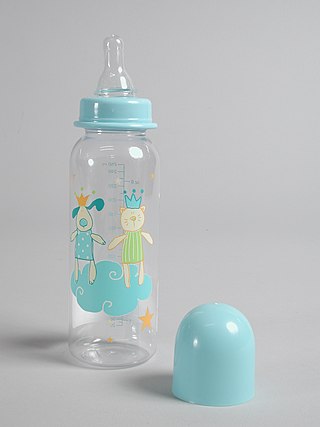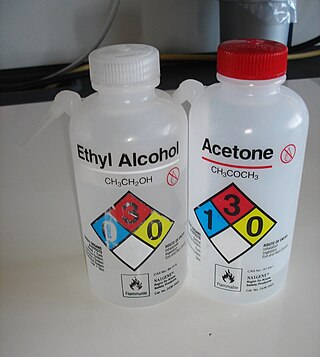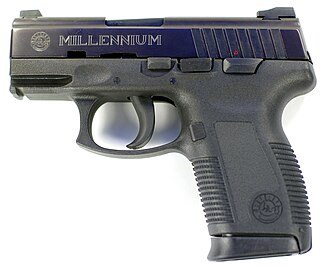
Polyvinyl chloride (alternatively: poly(vinyl chloride), colloquial: polyvinyl, or simply vinyl; abbreviated: PVC) is the world's third-most widely produced synthetic polymer of plastic (after polyethylene and polypropylene). About 40 million tons of PVC are produced each year.

Tabasco is an American brand of hot sauce made from tabasco peppers, vinegar and salt. It is produced by McIlhenny Company of Avery Island in south Louisiana, having been created over 150 years ago by Edmund McIlhenny. Although the tabasco peppers used in the sauce were initially grown only on Avery Island, they are now primarily cultivated in Central America, South America and Africa. The Tabasco sauce brand also has multiple varieties including the original red sauce, habanero, chipotle, sriracha and Trinidad Moruga scorpion. Tabasco products are sold in more than 195 countries and territories, and packaged in 36 languages and dialects.

Jolt Cola was a carbonated soft drink produced by The Jolt Company, Inc.. The cola drink was created in 1985 by C. J. Rapp as a highly caffeinated beverage. It was targeted towards students and young professionals, stressing its use as a stimulant in a similar manner as energy drinks. Its slogan reads "All the sugar and twice the caffeine!"

A baby bottle, nursing bottle, or feeding bottle is a bottle with a teat attached to it, which creates the ability to drink via suckling. It is typically used by infants and young children, or if someone cannot drink from a cup, for feeding oneself or being fed. It can also be used to feed non-human mammals.

A drink can is a metal container designed to hold a fixed portion of liquid such as carbonated soft drinks, alcoholic drinks, fruit juices, teas, herbal teas, energy drinks, etc. Drink cans are made of aluminum or tin-plated steel. Worldwide production for all drink cans is approximately 370 billion cans per year.

A bottle cap or bottle top is a closure for the top opening of a bottle. A cap is sometimes colorfully decorated with the logo of the brand of contents. Plastic caps are used for plastic bottles, while metal with plastic backing is used for glass; plastic caps are commonly made from polyethylene or polypropylene, while metal caps are usually either steel or aluminum. Plastic caps may have a pour spout. Flip-Top caps like Flapper closures provide controlled dispensing of dry products. Caps for plastic bottles are often made of a different type of plastic from the bottle.

A steel can, tin can, tin, steel packaging, or can is a container for the distribution or storage of goods, made of thin metal. Many cans require opening by cutting the "end" open; others have removable covers. They can store a broad variety of contents: food, beverages, oil, chemicals, etc. Steel cans are made of tinplate or of tin-free steel. In some dialects, even aluminium cans are called "tin cans".

Nalgene is a brand of plastic products developed originally for laboratory use, including items such as jars, bottles, test tubes, and Petri dishes, that were shatterproof and lighter than glass. The properties of plastic products make them suitable for work with many substances in various temperature ranges.

A plasticizer is a substance that is added to a material to make it softer and more flexible, to increase its plasticity, to decrease its viscosity, and/or to decrease friction during its handling in manufacture.

A water bottle is a container that is used to hold liquids, mainly water, for the purpose of transporting a drink while travelling or while otherwise away from a supply of potable water.

A Mason jar, also known as a canning jar or fruit jar, is a glass jar used in home canning to preserve food. It was named after American tinsmith John Landis Mason, who patented it in 1858. The jar's mouth has a screw thread on its outer perimeter to accept a metal ring or "band". The band, when screwed down, presses a separate stamped steel disc-shaped lid against the jar's rim.

Cholula Hot Sauce is a brand of chili-based hot sauce, based in Stamford, Connecticut, manufactured in Chapala, Jalisco, Mexico by SANE, and licensed by McCormick. According to its manufacturers, Cholula hot sauce rates 1,000–2,000 on the Scoville scale though other sources measure it as being over three times as hot, at 3,600 Scoville units. The product is packaged in a glass bottle with a distinctive round wooden cap. Six varieties of Cholula are widely marketed in North America.
Lamy is a German pen manufacturing company. Josef Lamy, who was a sales representative for Parker Pen in Germany, founded the business in 1930 by purchasing the Orthos pen manufacturer. Lamy was a pioneer in the use of moulded synthetic plastics to make their products.

Sigg Switzerland AG is a Swiss manufacturing company with its headquarters in Frauenfeld. Sigg bottles are bottles designed and manufactured in Switzerland from aluminum and polypropylene or in China from stainless steel and glass. The company is famous because of the iconic shape its classic bottle and numerous designs which have led to its addition to the permanent design collection of the New York Museum of Modern Art.

A plastic bottle is a bottle constructed from high-density or low density plastic. Plastic bottles are typically used to store liquids such as water, soft drinks, motor oil, cooking oil, medicine, shampoo, milk, and ink. The size ranges from very small bottles to large carboys. Consumer blow molded containers often have integral handles or are shaped to facilitate grasping.

Home canning or bottling, also known colloquially as putting up or processing, is the process of preserving foods, in particular, fruits, vegetables, and meats, by packing them into glass jars and then heating the jars to create a vacuum seal and kill the organisms that would create spoilage.

The Taurus Millennium series is a product line of double-action only (DAO) and single-action/double-action hammerless, striker-fired, short recoil operated, semi-automatic pistols manufactured by Forjas Taurus S/A in Porto Alegre Brazil. The Millennium line was designed to contend in the civilian concealed carry firearms market, and to be sold as backup weapons for law enforcement officers.

A fifth is a unit of volume formerly used for wine and distilled beverages in the United States, equal to one fifth of a US liquid gallon, or 25+3⁄5 U.S. fluid ounces ; it has been superseded by the metric bottle size of 750 ml, sometimes called a metric fifth, which is the standard capacity of wine bottles worldwide and is approximately 1% smaller.

A growler (US) is a glass, ceramic, or stainless steel bottle used to transport draft beer. They are commonly sold at breweries and brewpubs as a means to sell take-out craft beer. Rarely, beers are bottled in growlers for retail sale. The significant growth of craft breweries and the growing popularity of home brewing has also led to an emerging market for the sale of collectible growlers. Some U.S. grocery stores, convenience stores, bars and restaurants have growler filling stations.

Bisphenol A controversy centers on concerns and debates about the biomedical significance of bisphenol A (BPA), which is a precursor to polymers that are used in some consumer products, including some food containers. The concerns began with the hypothesis that BPA is an endocrine disruptor, i.e. it mimics endocrine hormones and thus has the unintended and possibly far-reaching effects on people in physical contact with the chemical.



















